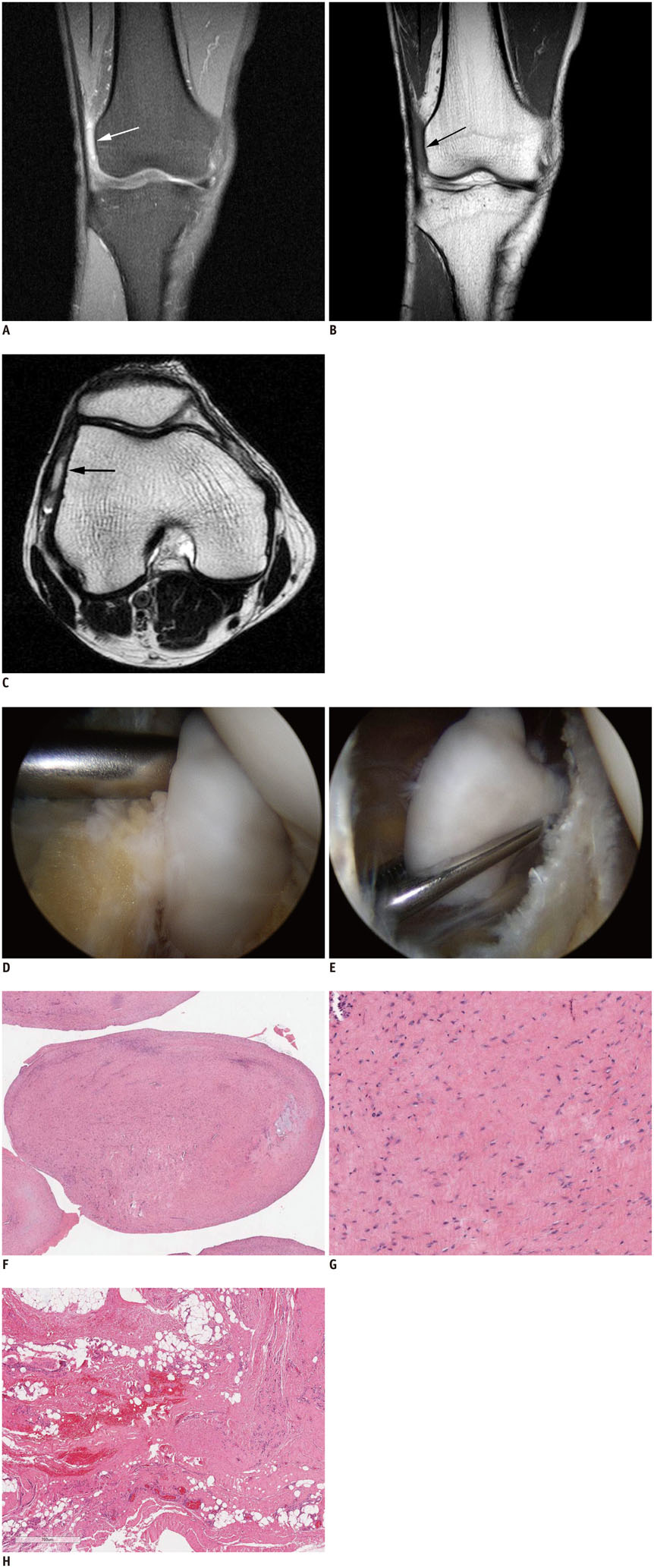Korean J Radiol.
2015 Feb;16(1):169-174. 10.3348/kjr.2015.16.1.169.
Intra-Articular Fibroma of Tendon Sheath in a Knee Joint Associated with Iliotibial Band Friction Syndrome
- Affiliations
-
- 1Department of Radiology, Dong-A University Medical Center, Busan 602-715, Korea. hdhdoc@naver.com
- 2Department of Pathology, Dong-A University Medical Center, Busan 602-715, Korea.
- 3Department of Orthopedics, Dong-A University Medical Center, Busan 602-715, Korea.
- KMID: 2069996
- DOI: http://doi.org/10.3348/kjr.2015.16.1.169
Abstract
- Iliotibial band (ITB) friction syndrome is a common overuse injury typically seen in the active athlete population. A nodular lesion on the inner side of the ITB as an etiology or an accompanying lesion from friction syndrome has been rarely reported. A 45-year-old male presented with recurrent pain and a movable nodule at the lateral joint area, diagnosed as ITB friction syndrome. The nodule was confirmed as a rare intra-articular fibroma of the tendon sheath (FTS) on the basis of histopathologic findings. We describe the MRI findings, arthroscopic and pathologic features, in this case of intra-articular FTS presenting with ITB friction syndrome.
Keyword
MeSH Terms
Figure
Reference
-
1. Lavine R. Iliotibial band friction syndrome. Curr Rev Musculoskelet Med. 2010; 3:18–22.2. Muhle C, Ahn JM, Yeh L, Bergman GA, Boutin RD, Schweitzer M, et al. Iliotibial band friction syndrome: MR imaging findings in 16 patients and MR arthrographic study of six cadaveric knees. Radiology. 1999; 212:103–110.3. Costa ML, Marshall T, Donell ST, Phillips H. Knee synovial cyst presenting as iliotibial band friction syndrome. Knee. 2004; 11:247–248.4. Nemeth WC, Sanders BL. The lateral synovial recess of the knee: anatomy and role in chronic Iliotibial band friction syndrome. Arthroscopy. 1996; 12:574–580.5. Mesiha M, Bauer T, Andrish J. Synovial sarcoma presenting as iliotibial band friction syndrome. J Knee Surg. 2009; 22:376–378.6. Hitora T, Yamamoto T, Akisue T, Marui T, Nagira K, Ohta R, et al. Fibroma of tendon sheath originating from the knee joint capsule. Clin Imaging. 2002; 26:280–283.7. Kundangar R, Pandey V, Acharya KK, Rao PS, Rao L. An intraarticular fibroma of the tendon sheath in the knee joint. Knee Surg Sports Traumatol Arthrosc. 2011; 19:1830–1833.8. Chung EB, Enzinger FM. Fibroma of tendon sheath. Cancer. 1979; 44:1945–1954.9. Moretti VM, de la Cruz M, Lackman RD, Fox EJ. Fibroma of tendon sheath in the knee: a report of three cases and literature review. Knee. 2010; 17:306–309.10. Jacobs E, Witlox MA, Hermus JP. Fibroma of tendon sheath located within Kager's triangle. J Foot Ankle Surg. 2014; 53:208–211.11. Hermann G, Hoch BL, Springfield D, Abdelwahab IF, Klein MJ. Intra-articular fibroma of tendon sheath of the shoulder joint: synovial fibroma. Skeletal Radiol. 2006; 35:603–607.12. Ciatti R, Mariani PP. Fibroma of tendon sheath located within the ankle joint capsule. J Orthop Traumatol. 2009; 10:147–150.13. Smith PS, Pieterse AS, McClure J. Fibroma of tendon sheath. J Clin Pathol. 1982; 35:842–848.14. Fox MG, Kransdorf MJ, Bancroft LW, Peterson JJ, Flemming DJ. MR imaging of fibroma of the tendon sheath. AJR Am J Roentgenol. 2003; 180:1449–1453.15. Glover M, Chebib I, Simeone FJ. Intra-articular fibroma of tendon sheath arising in the acromioclavicular joint. Skeletal Radiol. 2014; 43:681–686.16. Hornick JL, Fletcher CD. Intraarticular nodular fasciitis--a rare lesion: clinicopathologic analysis of a series. Am J Surg Pathol. 2006; 30:237–241.17. Pinar H, Ozkan M, Ozaksoy D, Pabuççuoğlu U, Akseki D, Karaoğlan O. Intraarticular fibroma of the tendon sheath of the knee. Arthroscopy. 1995; 11:608–611.18. Satti MB. Tendon sheath tumours: a pathological study of the relationship between giant cell tumour and fibroma of tendon sheath. Histopathology. 1992; 20:213–220.19. Pulitzer DR, Martin PC, Reed RJ. Fibroma of tendon sheath. A clinicopathologic study of 32 cases. Am J Surg Pathol. 1989; 13:472–479.20. Michels F, Jambou S, Allard M, Bousquet V, Colombet P, de Lavigne C. An arthroscopic technique to treat the iliotibial band syndrome. Knee Surg Sports Traumatol Arthrosc. 2009; 17:233–236.21. Strauss EJ, Kim S, Calcei JG, Park D. Iliotibial band syndrome: evaluation and management. J Am Acad Orthop Surg. 2011; 19:728–736.
- Full Text Links
- Actions
-
Cited
- CITED
-
- Close
- Share
- Similar articles
-
- Diagnosis of Iliotibial Band Friction Syndrome and Ultrasound Guided Steroid Injection
- A Case of Giant Cell Tumor of the Tendon Sheath withHistologic Findings Similar to Those of Fibroma of the Tendon Sheath
- Intraarticular Fibroma of the Tendon Sheath arising from the Infrapatellar Plica in the Knee
- Feasibility and reliability of various morphologic features on magnetic resonance imaging for iliotibial band friction syndrome
- Two Cases of Fibroma of Tendon Sheath


